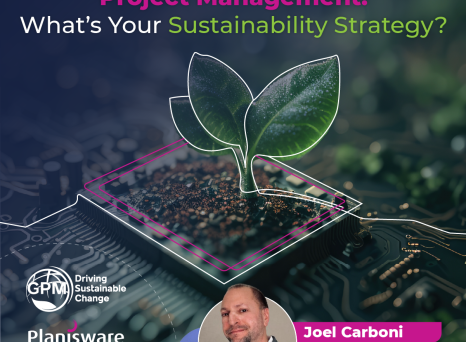In the space of one year, business leaders’ belief in the enterprise value of sustainability has shifted significantly.
In the space of one year, business leaders’ belief in the enterprise value of sustainability has shifted significantly. In 2022, Capgemini reported that only 21% of executives surveyed agreed there was a clear business case for sustainability. In 2023, that figure tripled to 63%.
This is a promising trend if you’re a Chief Sustainability Officer (CSO) who needs investment to scale their sustainability transformation program. But, leadership buy-in and budget can’t resolve all the challenges associated with delivering change throughout your organization. Many CSOs need to manage their program through multiple stakeholders across distributed business units. This includes navigating their complex infrastructure. Succeeding at sustainability transformation requires strategic alignment, high-quality data, and process efficiency. These are significantly harder to achieve at scale.
Thankfully, there are global organizations that show sustainability transformation at scale is possible. Let’s explore how Danone, Microsoft, and Google made real progress towards their sustainability goals, and how you can too.
Danone: Strategic Alignment and Data Integrity
In 2023, food and beverage company Danone published its Climate Transition Plan. The plan details Danone’s roadmap to help reach the 1.5C climate benchmark and Net Zero emissions by 2050. The Climate Transition Plan followed its Impact Journey, published earlier in the year. This defined its strategy and KPIs for sustainability.
A coherent strategy and straightforward metrics that align with organizational goals are strong foundations for a sustainability transformation program. They allow you to effectively communicate expectations to internal stakeholders and their teams. They also help investors and customers understand the intended direction and velocity of change.
To support its sustainability transformation, Danone needs accurate data. Rather than launching its own costly data-gathering program, it looked to credible third parties. Working together, they sourced reliable figures for hard-to-access metrics like Scope 3 carbon emissions (those that aren’t produced by an organisation’s owned or controlled assets). This includes data from lifecycle databases and professional federations like Plastics Europe.
It uses its data to identify areas where changes can make a tangible impact. That could be:
- Maximizing the filling rate of their transportation
- Creating lower carbon packaging
- Setting sustainability criteria for new suppliers
To use third-party data effectively, you need an efficient way to aggregate and analyze it alongside your own data streams. This enables a holistic overview that helps identify opportunities for more sustainable approaches at a glance. Having a centralized source of ESG data is also increasingly important in light of new ESG reporting regulations. Some project portfolio management (PPM) tools can centralize and analyze various data streams, as well as integrate ESG regulatory requirements. This can save you valuable time by streamlining your analysis and reporting process.
Microsoft: Investment in Sustainability Projects
In 2020, the software developer Microsoft made the commitment to become water-positive. This would mean replenishing the world with more freshwater than it uses.
Microsoft’s data centers consumed 3.6 billion liters of water in 2018 alone. To combat this, it has found innovative alternatives for cooling and humidifying its equipment. These included air, rainwater, and reclaimed water from utilities. In cooler locations, such as Sweden or Finland, Microsoft’s data centers don’t need to use the municipal water supply at all.
In 2023, Microsoft shared an update on its commitment. Beyond its direct reduction in freshwater use, it has also invested in key partnerships:
- It’s the first investor in the Water and Climate Resilience fund. This fund will create “climate-resilient” water and sanitation solutions for low-income populations across three continents.
- It’s partnered with Water.org to offer microloans to communities. This enables them to install toilets, taps, and better water storage solutions.
- It has integrated Ecolab into Microsoft Sustainability Manager. This now means organizations can more accurately measure and track their water consumption.
Few CSOs have access to Microsoft levels of budget for their sustainability investments. But, supporting sustainability projects, with money or time, is an effective way to scale your sustainability impact. If you’re pursuing this strategy, it’s important that you have access to a project portfolio overview. This should include external partnerships alongside internal initiatives.
Having this high level of visibility across your sustainability program supports faster, more strategic decision-making. It makes it easier to evaluate existing projects and new project proposals against your program’s current performance and sustainability goals. Armed with this knowledge, CSOs can make the best use of their budget by prioritizing, killing, or green-lighting the right projects at the right time.
Google: AI-Driven Optimization
In its 2023 Environmental Report, technology company Google updated the world on its progress towards its sustainability goals. One of the report’s opening sections highlighted the extent to which artificial intelligence (AI) is driving sustainability across its operations and for its customers. For its users, Google is making it easier to live more sustainably with AI-powered features. This includes eco-friendly routing in Google Maps and personalized energy-saving recommendations from Nest thermostats.
In its own operations, Google previously used AI to reduce energy consumption at its data centers by as much as 40%. Now, it’s using AI to optimize when and where it completes computational tasks. The AI bases its decision on whether the data center can use carbon-free energy. It has also developed a way to train its AI models with up to 100 times less energy and 1000 times lower emissions.
Google is a compelling case study of AI’s value for sustainability transformation, though it’s important to consider the carbon footprint associated with AI itself.
Not every organization creates products they can enhance with AI. But, every CSO can take advantage of AI to accelerate their sustainability goals. The use cases include:
- Improving resource utilization. Energy efficiency is central to any sustainability transformation program. Using AI-driven Particle Swarm Optimization (PSO), CSOs can quickly identify the most efficient ways to run projects.
- Boosting data accuracy. CSOs need high-quality data to track and analyze the progress of their sustainability transformation program accurately. AI-enhanced tools can detect and flag anomalies, helping improve data quality over time.
- Increasing forecasting accuracy. Using historical project data, CSOs can train an AI predictive analytics model to estimate the outcomes of their sustainability projects. This can indicate significant risks or success conditions.
While there are no shortcuts in sustainability transformation, CSOs can set themselves up for success with the right tools. A PPM tool can give you the visibility, analytical power, and collaborative features you need to unite business units and navigate complexity with ease.


